-
Posts
10,302 -
Joined
-
Last visited
Content Type
Profiles
Forums
Events
Gallery
Posts posted by Capt. Sterling
-
-
-
Mickey Souris might know more about these particular coats, as he has put a lot more time into studying uniforms of the time.
-
Vertical pockets were pretty popular for the earlier coats
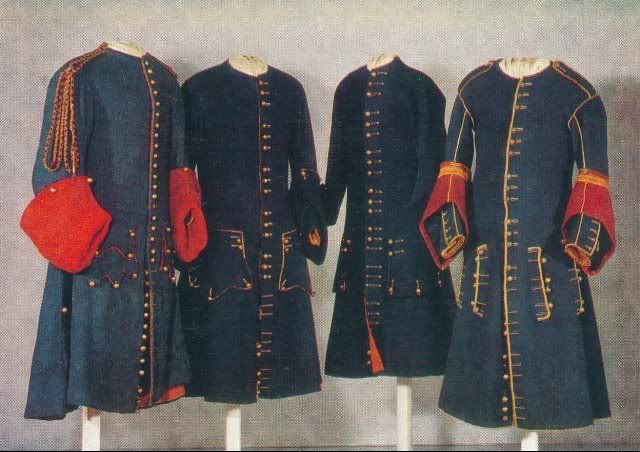
Could you tell us more about this picture? Periods and such?
French made uniforms sent to Sweden circa 1686... I have read that they were sent to be copied by the Swedish...
-
Ah... they just get stuck on all the damn buttons....

Ah... they just get stuck on all the damn buttons....

-
make that denotes
yeah t'is Monday
-
Hmmm mine doesn't help holding my breeches up, the gusset and a sword carriage are the only things that keep my breeches in place, that and too much food at Christmas...
as to getting in the way of fighting, mine doesn't but I wear mine short, like ye see in many of the period illustrations...not these long, wrap around yer ankle Jack Sparrow things... damn, would hate to be up in the rigging with one of those flapping in the breeze, not that my character would be up in the rigging often any way unless by choice..... the skirts of the frock coat get more in the way than anything else...and the large cuffs, which will catch on just about anything... and the wig on a very windy day.... I guess I could go on and on from experience.... but not my sash...
Also a fashion item but also donates rank as well...
also giving the thread a quick once over, doesn't actually look like it was aimed at the sailor/pirate type
-
Hmmm certainly seeing information on drawstring waistbands on drawers (underwear) although these also had waistbands like breeches with buttons as well
-
Hmmmm braces as they are known overseas, (suspenders being suspender belt or what Americans call a garter belt) are also known as Gallows or Galusses... the more "modern" variety, or closer to what we know and use, were pretty much created about 1820....although according to C. Willett & Phillis Cunnington's The History of Underclothes, braces appear on the scene JUST prior to the 1800s...Ben Franklin had a set. Supposedly and I have yet to come accross any pictorial evidence, they were a pair of ribbons or leather tied to the waistband with more ribbon... and seem to be something the French invented in the 18th century... unfortunately all I am seeing is Late 18th century.
There is an account in the Holly Trees Museum in Colchester regarding a pair of morocco-leather braces, 5/-.
The word used by the man of fashion for this appliance was, in his case, very appropriate. A 'brace' tightens a grip and his bracess served not merely to to suspend but also to tighten the buckskin breeches as much as possible (which were the fashion in the early 1800s) The labourer, on the other hand, who naturally cound not work in tight garments on his legs, retained the old-fashioned word 'gallows', which had been formerly applied to any kind of suspensory device for holding up a garment, and henceforth used it to speak of his braces.. chapter 1791-1820. Page. 68.
Braces were considered right up to and including the 20th century as 'underwear', so we might not come across too many illustrations of them even if we look harder for em...
Still looking up belt loops, although the belt as a fashion item for holding up trousers does not seem to actually occur until 1930s....
as to Gaop, one way of keeping control of a waistband is to have a gusset in the back, this opening, which laces, allows you to tighten or loosen after too much food...ahem... the waistband. This certainly does help keep breeches up where they should be ... hope this helps... if I do come across more on belt loops, have found something I need to investigate a bit more on loops on the bands, which appears in some info from 1841-1856... will post it here...
Hope this helps
-

So doesn't prove them as being common, doesn't prove them uncommon, just shows they did have em, at least in civilian clothing. And don't forget that one painting of the fellow with his hounds and gun, with what looks to be brown velvet pants that Ivan Henry, I believe, posted.
ah, found the original, knew I had it some where... also Waugh has two late 17th century breeches patterns with vertical cuts in the front near the waistband which could possibly be for pocket openings... um page. 37 "The Pockets, are little bags let in the sides of the Breeches to put or carry any small thing in... The Cut of Men's Clothes 1600-1900 Norah Waugh
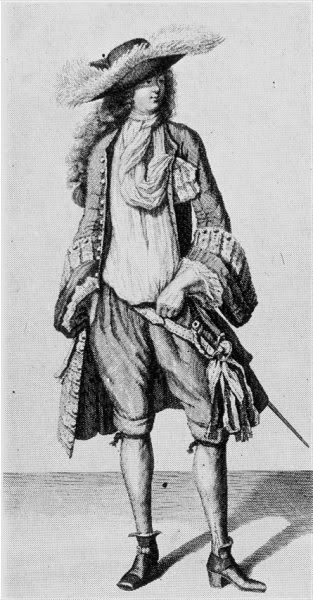
Dutch sailor
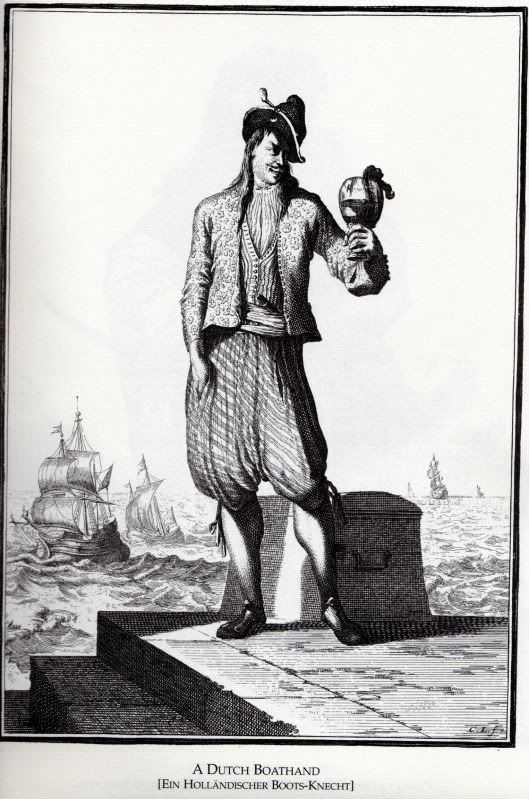
The Dutch Mariner print from the same series as above has pocket, and there are several other pocket views in several of the woodcuts Foxe posted awhile back...not sure as to the date on those... page 94 Edward Lowe & page 88 George Lowther
-
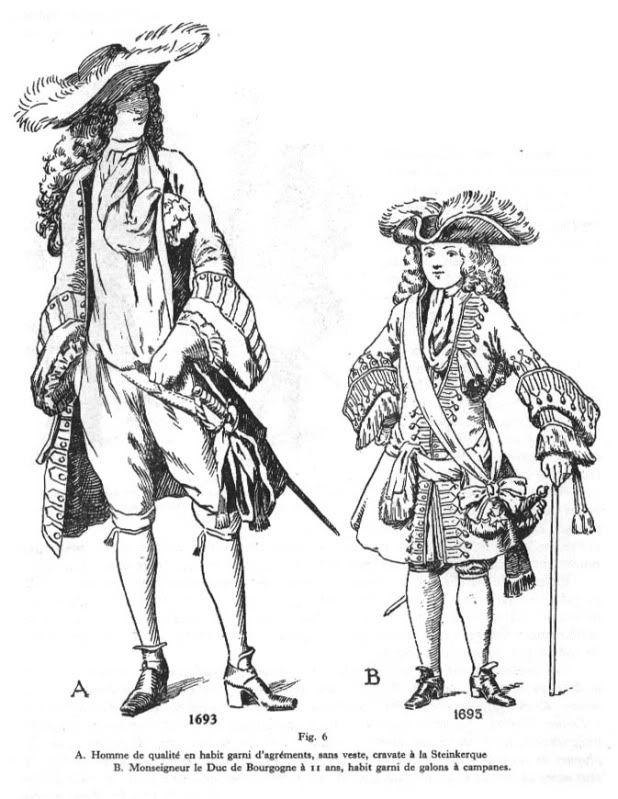
Not saying he certainly is but the figure circa 1693 looks as if he could have his hand in his right pocket... (illustrations are taken from originals)
-
-
Physical description
Coat and breeches for a boy of fine red wool embroidered with silver-gilt thread. Wool, faced with silk twill, lined with cotton twill, embroidered with silver thread and hand-sewn.
[breeches] Breeches with a fly front fastening with three buttons worked with silver-gilt thread. The fronts are faced with red silk twill. Two large buttons at the front waist, and a centre back opening with two eyelet holes to allow for a tape adjustment.
Two pockets are let into the waistband at the front, each with a button fastening. On each front there is a horizontal pocket which fastens at the hip with a single button. There are two side pockets faced with red silk twill. All the pocket bags are of chamois leather.
The legs are open at the knee and fastens with five buttons. The knee band originally has a gathering tape to fit the breeches around the leg. Each opening also has a 'puff' of red silk twill.
Lined with cotton twill.
Place of Origin
England, Great Britain (made)
Date
1700-1705 (made)
Artist/maker
unknown (production)
Materials and Techniques
Wool, faced with silk twill, lined with cotton twill, embroidered with silver thread and hand-sewn
Dimensions
[breeches] Circumference: 30 in waist, Circumference: 76 cm waist, Length: 14.5 in inside leg, Length: 37 cm inside leg, Depth: 1 in waistband at back, Depth: 2.5 cm waistband at back, Circumference: 13.5 in around leg, Circumference: 34.5 cm around leg, Depth: 3 in waistband at front, Depth: 7.5 cm waistband at front
Descriptive line
Coat and breeches for a boy of fine wool embroidered with silver-gilt thread, England, 1700-1705
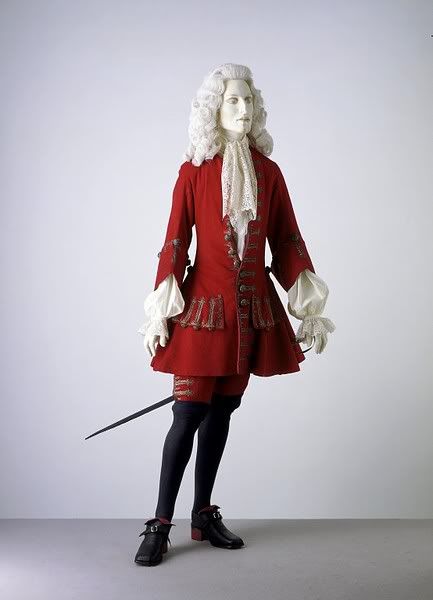
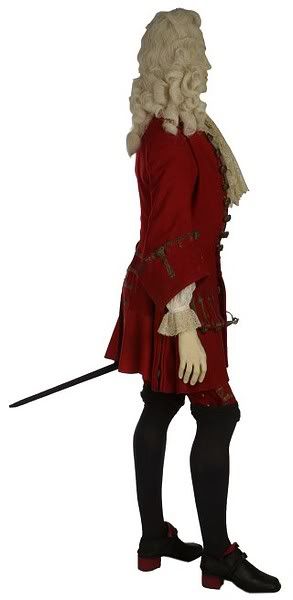
-
Object history note
The doll and its partner are thought to have belonged to the Cockerell family, descendants of Samuel Pepys. The daughter of Pepys' nephew, John Jackson (son of his sister, Pauline) married a Cockerell. The doll and its partner were named 'Lord' and 'Lady' of the family home in Clapham.
Historical significance: The doll and its partner are costume documents; their clothes being, in style, cut and material, perfect miniatures of the fashions of the late 17th century. Their importance is underlined by the almost total lack of other good visual material for this period, whether pictorial or in the form of surviving garments. In particular, the survival of accessories and the informal garments is extremely rare.
Historical context note
Dolls were widely produced in the 17th century, although very few survive. It is most unlikely that these particular examples were the playthings of children. Their production is of a high quality, almost all the accessories survive and there is little wear and tear on the dolls and their garments. They were most probably purchased for the amusement of adults, and as a decorative accessory to a home.
Descriptive line
Lord Clapham's breeches, silk with a floral pattern, fly front with flapped pockets and lined with chamois, London, 1690-1700
Bibliographic References (Citation, Note/Abstract, NAL no)
Hillier, Mary, Pollock's Dictionary of English Dolls, London: Robert Hale Ltd, 1982, 50-51, 202pp. ill
-
Physical description
Breeches of silver tissue, probably French, in a semi-naturalistic floral pattern carried out in pair shoots of plain silver thread on a white silk tabby ground. They have a fly front and a flapped horizontal pocket at each hip, lined with chamois leather, the flaps faced with silk matching the coat lining. To the left side is stitched the sword hanger, of the same silver tissue, lined with blue spotted silk. The breeches are lined with white flannel. Made for the Lord Clapham wooden doll.
Place of Origin
London, England (made)
Date
1690-1700 (made)
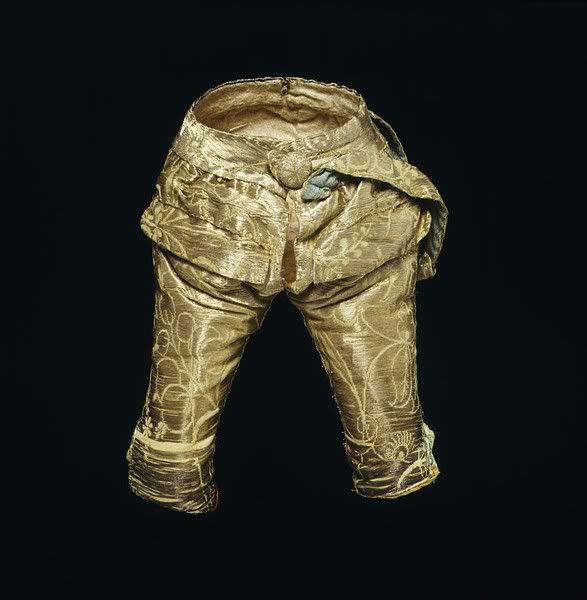


-
FWIW regarding pockets (no the items posted here are not sailors clothes)
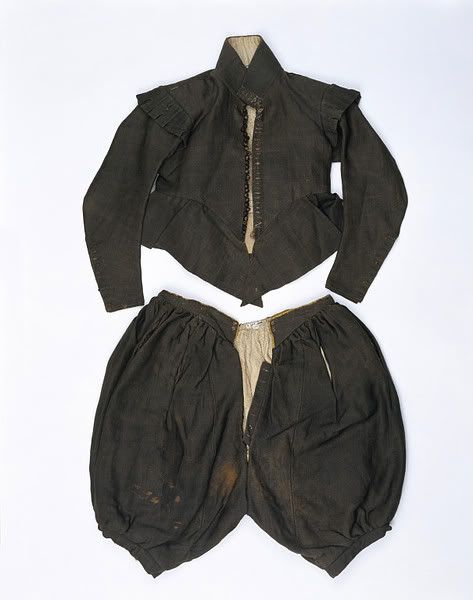
[breeches] Serge (wool twill) breeches, probably once black now faded to dark brown with a waistband and fly front. The very full legs are gathered into a band of serge above the knees. The breeches are lined with linen shag, interlined with coarse brown wool and stuffed at the knees with probably unspun wool. The top and front edge of the waistband is bound with green and purple silk ribbon. A placket of serge on the left front edge bears 7 unworked buttonholes corresponding to 5 remaining buttons (round wooden core covered with plaited black silk thread) on the right front. There are 2 worked eyelets on either side of waistband front. No worked eyelets can be found to correspond with the doublet lacing band, but a series of holes in the waistband suggests an aiglet was pushed through the fabric. A bound opening on each side of the front opening and one at each side seam indicates the placement of 4 pockets. A chamois pocket lining remains only at the left seam.
Doublet and breeches
-
Place of origin:
England, Great Britain (made) -
Date:
1625-1635 (made) -
Artist/Maker:
unknown (production) -
Materials and Techniques:
Wool, trimmed with silk and lined with linen
-
Wishing all a happy & blessed new year.
-
Ahem.......
And a merry Christmas to ye as well & the rest of ye notorious lads & lasses.
-
Wishing ye a very blessed birthday William. Hope ye had a grand day of it.
-
Welcome to the pub.
-
Supposedly Luyken was trying to show what was currently being worn around other parts of the world. (BTW landlubbersanonymous, thank ye for sharing that link, I only have the reprint...nice to see an earlier edition. ) Haven't read it in years, but I think the Sea Rover's Practice makes mention that the Spanish were slower to change and retained a mixture of old and new styles in weapons, perhaps that flowed over to fashion as well... although Mister Hook, does have a point, there is a lot of formal attire shown in Luyken's plates...
-
battery park has continued to grow. so much that it is a bit unwieldy on the point so the extra room will indeed be nice. now if we can just get lawrence to ..... oh never mind.
I'll bring the shackles....
-
Great news about battery point!
-
Thank ye so very much.
-
Happy birthday


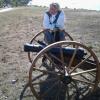
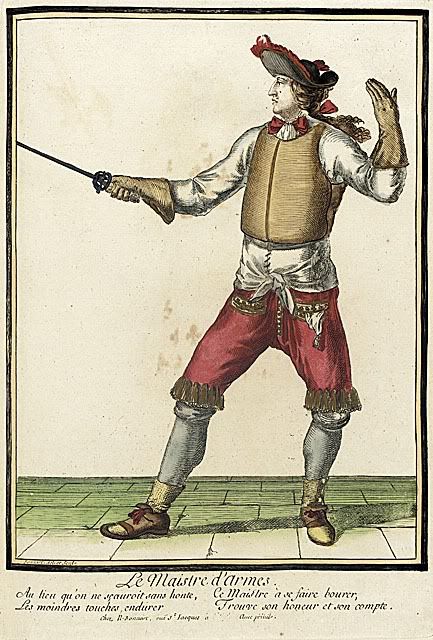
Android phone fatal error report
in Pub Status
Posted
Ahoy Stynky...
getting this on the phone whilst trying to access the pub...
"
Fatal error: call to undefined method skin _ipchat_3:chatMobileLink() . . ./iupcugzxz etc, etc, etc. . .
is this something I need to correct on the phone... or is it on the pub's end? If ye need the entire message let me know, and I will pm ye with it... thanks.